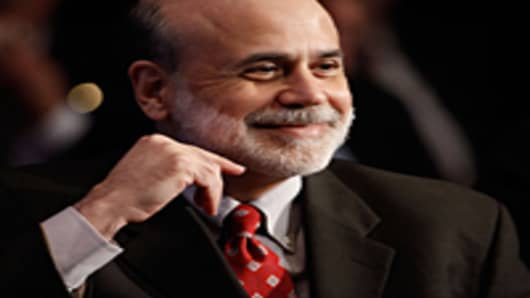Spring may be in the air, but the long winter is hardly over for the U.S. economy. So expect the Federal Reserve’s policy-setting committee to keep its hot-house approach in place for at least for one more meeting.
Though there’s virtually no chance the FOMC will change interest rates or key monetary policy language at its March 16 meeting, change of another sort is imminent.
Come March 31, the Fed is expected to have finished a year-long program involving the purchase of some one and a quarter trillion dollars of mortgage-backed securities, which has been widely credited with pumping up the housing market.
“There's a lot of anxiety about that,” says economist Ram Bhagavatula, managing director of the hedge fund Combinatorics Capital.
The big question is how much mortgage rates will rise and how quickly as a result, even if the central bank has kept the door open about reviving the program.
In some ways, it’s a first step in bringing some uncertainty back into the markets. (After all, the recent discount rate was ultimately written off as a mechanical move without any implications for liquidity or monetary policy.)
For now, that’s probably more than enough for the markets and in that context might be reason enough for the Fed not to tinker with the now legendary centerpiece phrase of its policy statement: "economic conditions…are likely to warrant exceptionally low levels of the federal funds rate for an extended period."
That phrase, added to the FOMC statement in February 2009, has been something of a security blanket for investors.
Much like the Greenspan Fed did during a seven-month period in 2003-2004, when rates were then at the record low of 1 percent, economists expect a series of subtle yet telling changes in policy language to let the market down easy and telegraph the imminent arrival of a rate increase.
“We do have sort of a precedent," says long-time Fed watcher David Jones of DMJ Advisors.
A change in that phrase or its outright replacement will happen at either the April or June meetings, according to many economists. The minority view is the summer or early fall.
“They’re getting close to one," says Robert Brusca, chief economist at Fact & Opinion Economics. “They’re going to change the language before they do anything else.”
Regardless of the timing, the move will signal the beginning of the end of cheap money but not the end itself.
The Fed's current phrase has been in place for twice as long as its equivalent one of the 2003-2004 period and at least one FOMC member, Thomas Hoenig, the Kansas City Fed boss, says it has outlived its usefulness.
In the 2003-2004 period, the buzz phrase—“policy accommodation can be maintained for a considerable period’’—was featured in FOMC statements from August to December.
In January 2004, it morphed into “patient in removing ... policy accommodation.”
In May of that year, the FOMC famously lost its patience, adopting the phrase, “policy accommodation can be removed at a pace that is likely to be measured.”
At the next meeting—a month later—the Fed began a long series of quarter-point hikes in the fed-funds rate, while keeping that language in place. There was little confusion and even less negative reaction in the markets. In fact, it was almost an anti-climax.
“I could see a phased change in language,” says Chris Varvares, president of Macroeconomic Advisers, though he doesn’t see that starting until late 2010 or early 2011. “That would be a sign something will happen” in six months. (Yes, that would mean the first rate hike would come in the summer of 2011.)
Sending clear and effective signals, however, may not be as simple this time. The Fed’s monetary-policy machine now has more moving parts than the fed-funds and discount rates.
There are liquidity programs, lending facilities and new telltale interest rates, such as the one the central bank pays banks on excess reserves—cash above and beyond what banks are required to keep on hand.
There’s ample disagreement in the market about what the best indicators are, nevermind what the Fed wants people to key on.
“They’ll still change the language, but language will be less important this time,” says Jones. “The market is interpreting that the Fed will place less emphasis on the language and more on what it is doing with the new tools.”
“The Fed wants the markets to “focus on monetary-policy changes that will come from the FOMC and not misinterpret reserve-draining actions as signaling much about monetary-policy changes,” counters Varvares.
Policy statements are arguably more definable that tinkering with a new set of tools.
What’s more, this economic recovery has already challenged conventional thinking and bedeviled more than a few forecasters.
Given that, Brusca says there’s peril to changes in policy language.
“You don’t want to change the language too soon without knowing a change [in conditions] is coming,” he says.
The Fed’s “exit strategy is both overwhelming and untested,” adds Jones, which is why he thinks there will be “early testing of these new tools.”
All of this could make for a bumpy ride along the way, despite the Fed’s best intentions to engineer a smooth transition.
Ultimately, the Fed may not achieve its end until the last minute, using a tried-and-true method.
“I don’t think they will tighten without signaling at the previous meeting,” says Bhagavatula.




